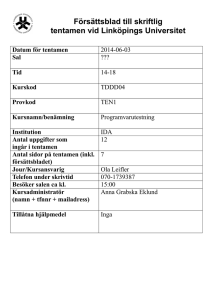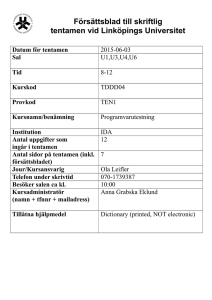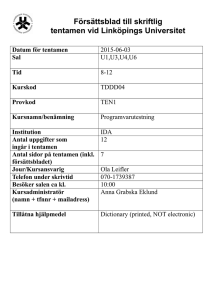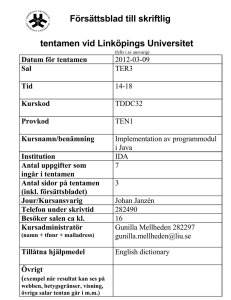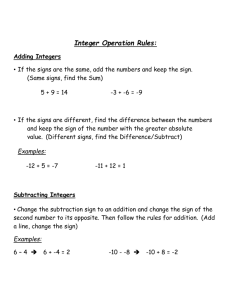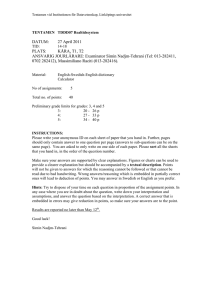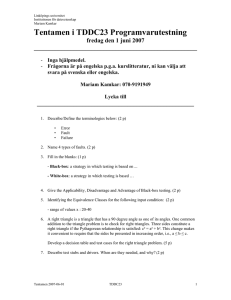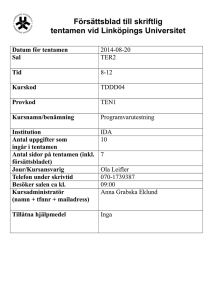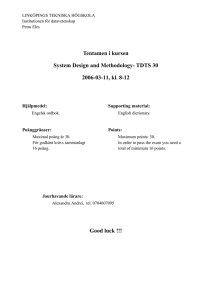Försättsblad till skriftlig tentamen vid Linköpings Universitet
advertisement
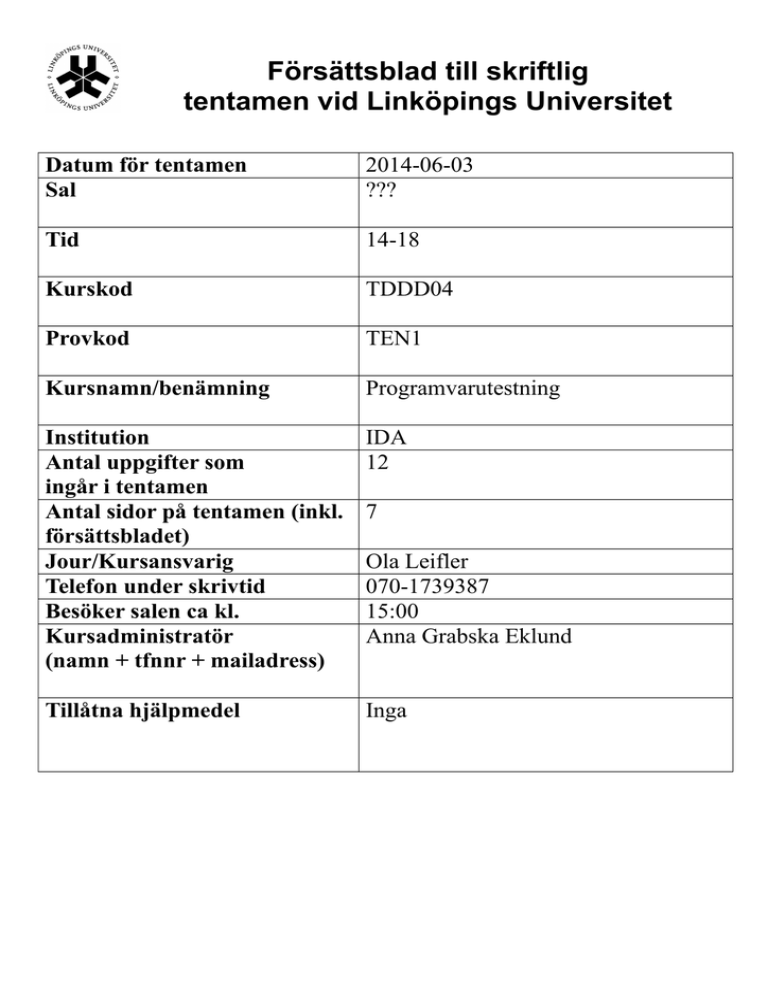
Försättsblad till skriftlig
tentamen vid Linköpings Universitet
Datum för tentamen
Sal
2014-06-03
???
Tid
14-18
Kurskod
TDDD04
Provkod
TEN1
Kursnamn/benämning
Programvarutestning
Institution
Antal uppgifter som
ingår i tentamen
Antal sidor på tentamen (inkl.
försättsbladet)
Jour/Kursansvarig
Telefon under skrivtid
Besöker salen ca kl.
Kursadministratör
(namn + tfnnr + mailadress)
IDA
12
Tillåtna hjälpmedel
Inga
7
Ola Leifler
070-1739387
15:00
Anna Grabska Eklund
LiTH, Linköpings tekniska högskola
IDA, Institutionen för datavetenskap
Ola Leifler
Written exam
TDDD04 Software Testing
2014-06-03
Permissible aids
Dictionary (printed, NOT electronic)
Teacher on duty
Ola Leifler, tel. 070-1739387
Instructions and grading
You may answer in Swedish or English.
Your grade will depend on the total points you score on the exam. The maximum
number of points is 86. The following grading scale is preliminary and the limits
may be lowered after grading.
Grade
3
4
5
Points required
42
58
73
Important information: how your answers are assessed
Many questions indicate how your answers will be assessed. This is to provide some
guidance on how to answer each question. Regardless of this it is important that you
answer each question completely and correctly.
Several questions ask you to define test cases. In some cases you are asked to provide
a minimal set of test cases. This means that you can’t remove a single test case from
the ones you list and still meet the requirements of the question. Points will be
deducted if your set of test cases is not minimal. (Note that “minimal” is not the same
as “smallest number”; even when it would be possible to satisfy requirements with a
single test case, a set of two or three could still be minimal.)
You may find it necessary to make assumptions in order to solve some problems. In
fact, your ability to recognize and adequately handle situations where assumptions are
necessary (e.g. requirements are incomplete or unclear) will be assessed as part of the
exam. If you make assumptions, ensure that you satisfy the following requirements:
You have documented your assumptions clearly.
You have explained (briefly) why it was necessary to make the assumption.
Whenever you make an assumption, stay as true to the original problem as possible.
You don’t need to be verbose to get full points. A compact answer that hits all the
important points is just as good – or better – than one that is long and wordy. Compact
answers also happen to be quicker to write (and grade) than long ones.
Please double-check that you answer the entire question. In particular, if you don’t
give a justification or example when asked for one, a significant number of points will
always be deducted.
1.
Terminology (4p)
Explain what “black-box testing” is. Briefly explain one test case design methodology
that can be used for black-box testing. (4p)
2.
Coverage criteria (8p)
a) Order the following coverage criteria with respect to their requirements on test
cases in ascending order:
1. Decision Coverage
2. Condition Coverage
3. Branch Coverage
(2p)
b) Explain Modified decision/condition coverage with a code example (2p)
c) Explain coverage criteria that can be used for loops (4p)
3.
Test automation (6p)
When should you use a test automation framework such as CPPUNIT/JUnit instead
of
a) stepping through a debugger (2p)
b) writing debug information to the console (2p)
c) running an application and inspecting the results (2p)
4.
Easy points (6p)
Answer true or false:
a) One goal of software testing is to verify that the system under test (SUT) contains
no errors.
b) MM-Paths can be used for both unit testing and integration testing.
c) A symptom is the observable effect of executing a bug.
d) Requirements reviews are in general better than code inspections at finding faults
in applications.
e) Equivalence-class testing subsumes decision-table testing.
f) The control script for data-driven test scripts requires little effort to set up.
(It’s not worth guessing: you get 1p for correct answer, 0p for no answer, and -1p for
incorrect answer; you can get negative points on this question.)
5.
Black-box testing (16p)
The Swedish Tax Authority Skatteverket has the following rule for paying road user
charges (tolls) for foreign heavy vehicles, simplified for this question:
“[The toll] depends on what distance you are intending to drive on a toll road, the
emission category of your vehicle (EURO 0, 1 or 2) and the number of axles of the truck
or truck/trailer combination. You can pay for day [or week]. For more details, please see
the [tariff table below].
Note that the chargeable period for day is 00.00-24.00. So, if a journey on a toll road
begins, for example, at 21.30 on one day and finishes at 02.30 next day, payment for two
days is required.
Tolls are paid in SEK.”
Toll Tariff 2014
Max
axles
Emission
Class
1 day
1 week
3
3
3
4
4
4
0
1
2 or cleaner
0
1
2 or cleaner
67
67
67
67
67
67
220
194
169
347
313
279
For a hypothetical software system that produces the toll charge given the information
above, select a test case design methodology and use it to define a minimal set of test
cases (according to that methodology). Justify your choice of methodology! You will
be evaluated on both your choice of methodology, justification, and application of the
methodology.
6.
Basis path testing (10p)
Use basis path testing to define test cases for the following programs.
int f(int x, int y) {
bool x_neg;
if (x > 0) {
x_neg = false;
}
else {
x_neg = true;
x = -x;
}
if (y > 0) {
if (x_neg) {
y = -(y * y);
}
else {
y = y * y;
}
}
else {
y = -(y * y);
}
return x + y;
}
You are required to draw the appropriate graphical representation of the program and
illustrate the process of selecting paths. For each test case, indicate which basis path
the test case corresponds to, in addition to the other information required for a test
case. You will be assessed on the quality and completeness of your test cases, as well
as your explanation of the basis path selection process.
7.
Code Complexity measures (6p)
Explain cyclomatic complexity and essential complexity, and their relationship to
testing. For full points, provide a code example that describes the relationship
between cyclomatic complexity and essential complexity.
8.
Integration testing (6p)
a) State one advantage big-bang integration has over most other methods. (2p)
b) In the context of integration testing, what is a driver? (2p)
c) In the context of integration testing, what is a stub? (2p)
9.
Exploratory testing (6p)
a) Explain the difference between exploratory testing and ad-hoc testing. (2p)
b) How can exploratory testing be justified as a test method? (2p)
c) In terms of exploratory testing, what is a charter? (2p)
10.
Multiple condition coverage (10p)
Specify a minimal set of test cases for the following function that result in 100%
multiple condition coverage.
int rules(bool a, bool b, bool c, bool d) {
if (a || b) {
if (~b || c) {
return 1;
}
return 2;
}
else if (c && d) {
return 3;
return 4;
}
11.
Testing in agile development (4p)
Describe two techniques for system-level testing in agile development, where fast
releases and continuous delivery is critical. For full points, use concrete examples of
how to implement your chosen techniques.
12.
More easy points (4p)
Answer the following questions true or false:
a) Automated testing is effective for ensuring that old bugs are not reintroduced.
b) Automated tests are cheap to create.
c) Automated testing is appropriate in an agile environment.
d) By automated testing people usually mean testing where tests are run
automatically, but inputs and outputs are created by hand.
(It’s not worth guessing: you get 1p for correct answer, 0p for no answer, and -1p for
incorrect answer; you can get negative points on this question.)
